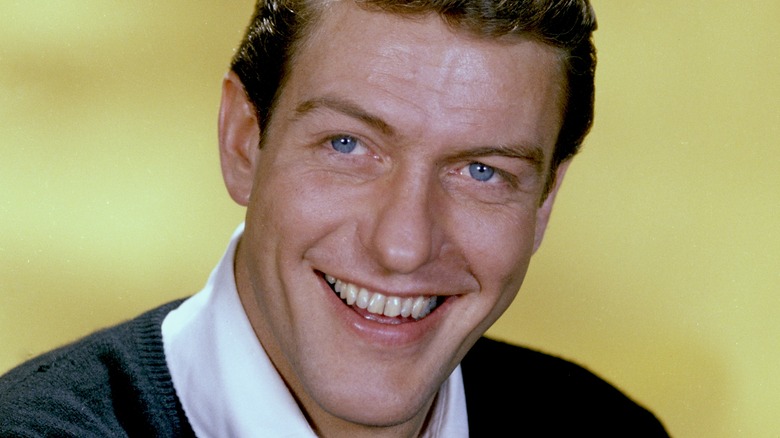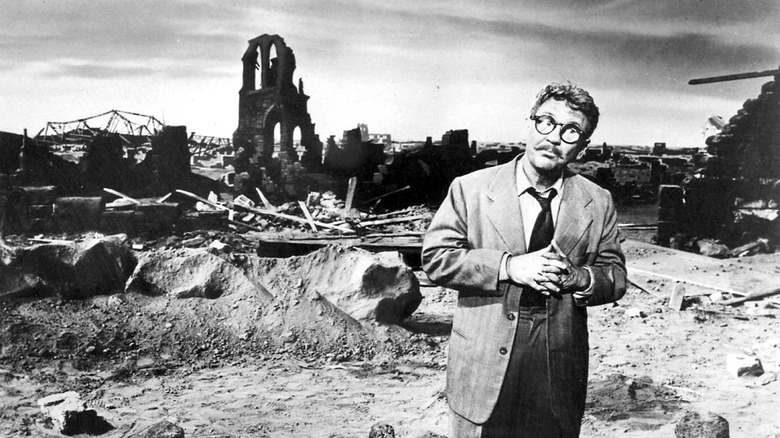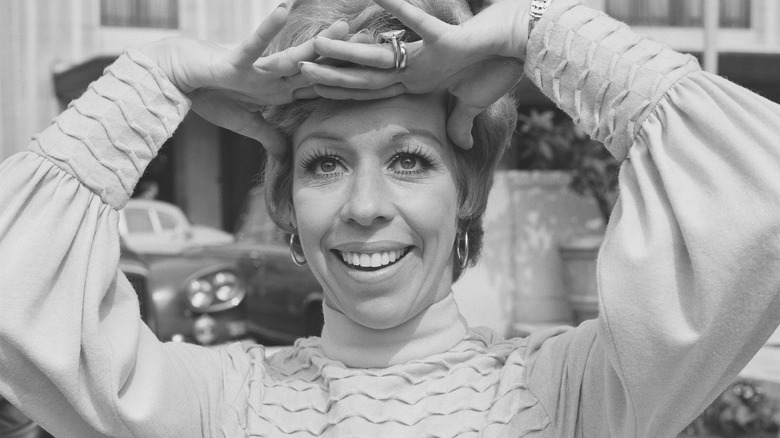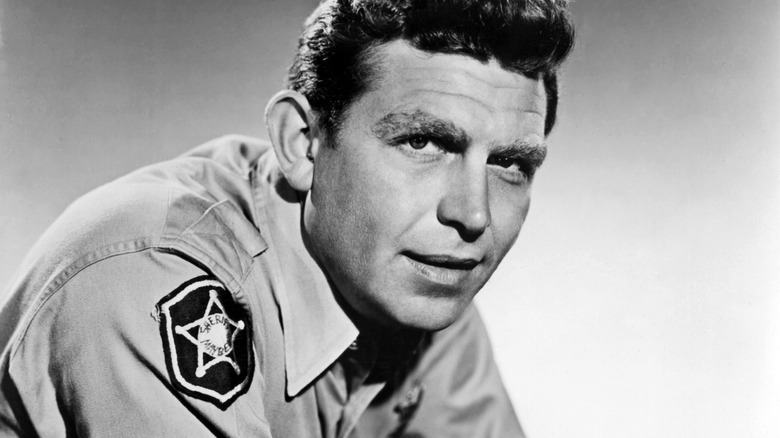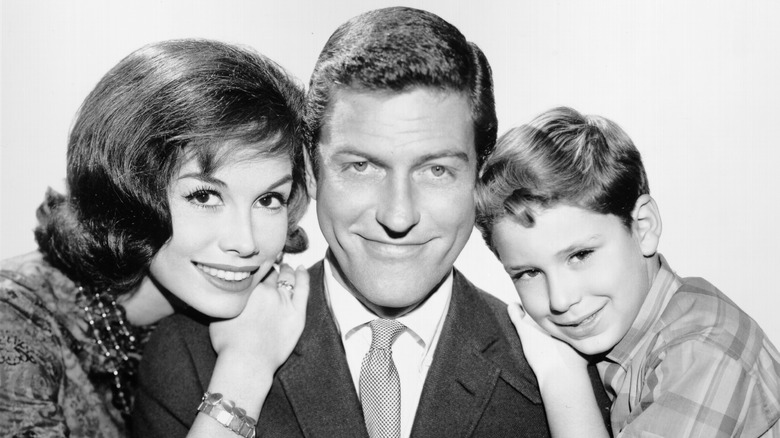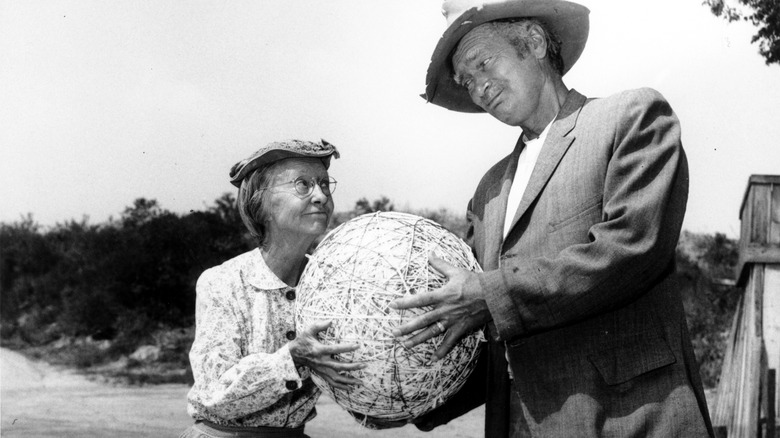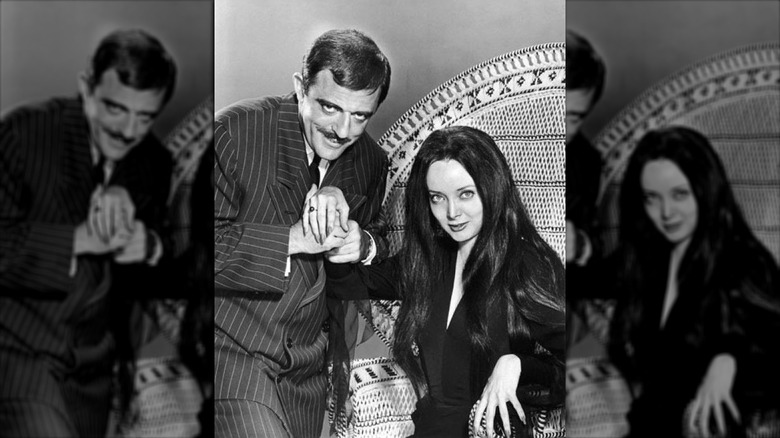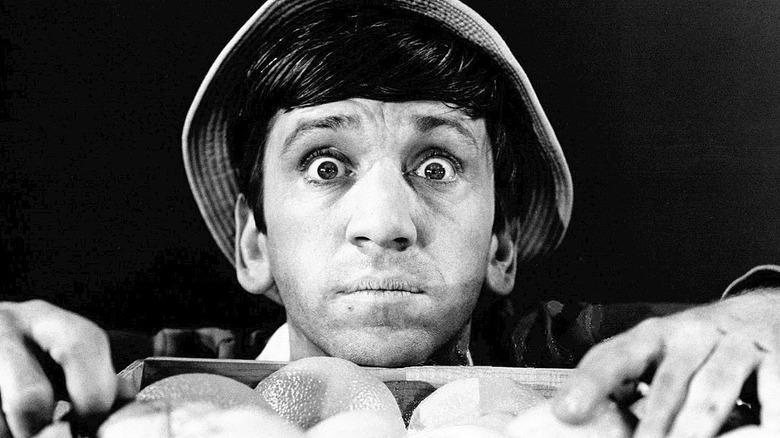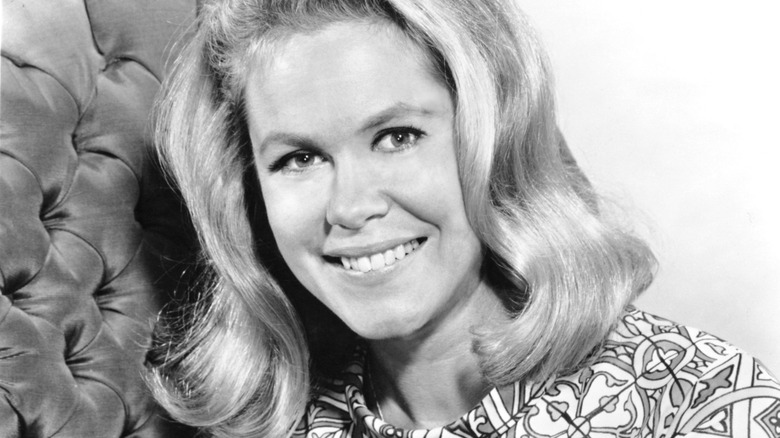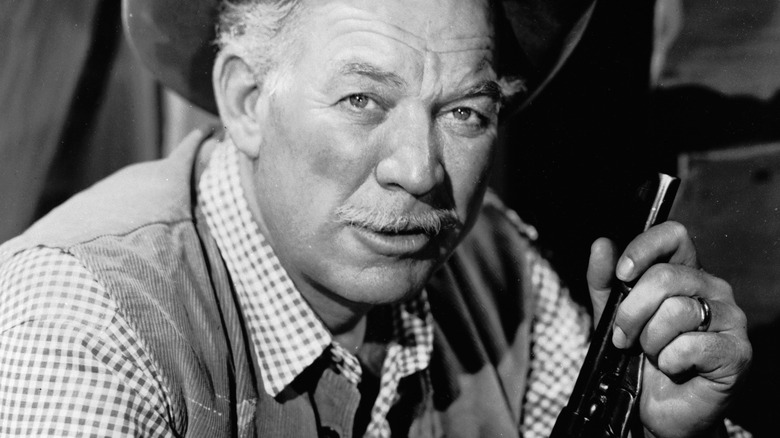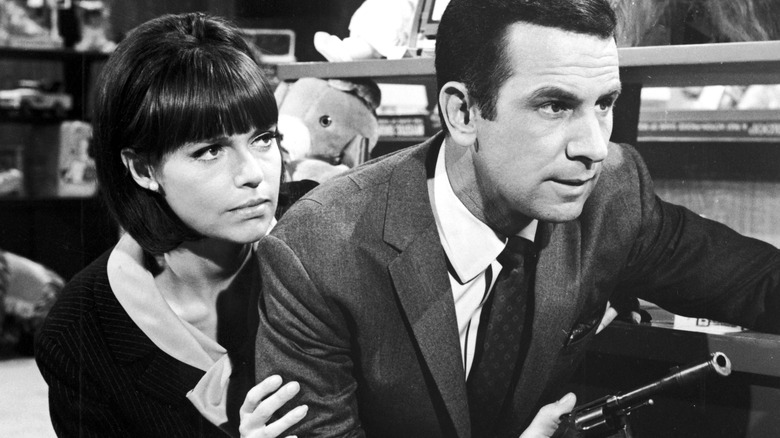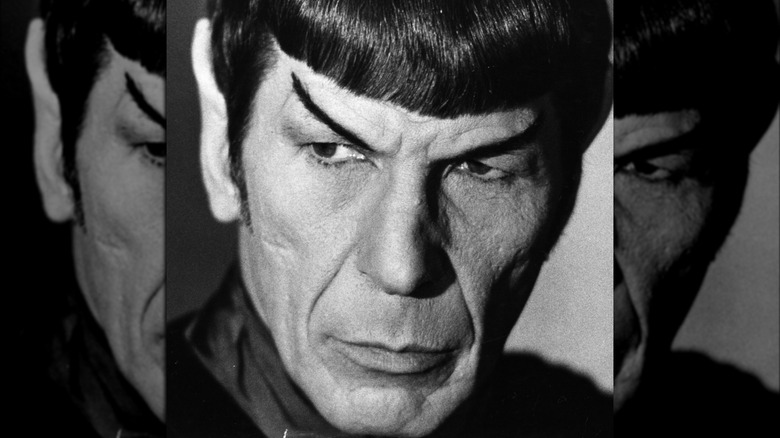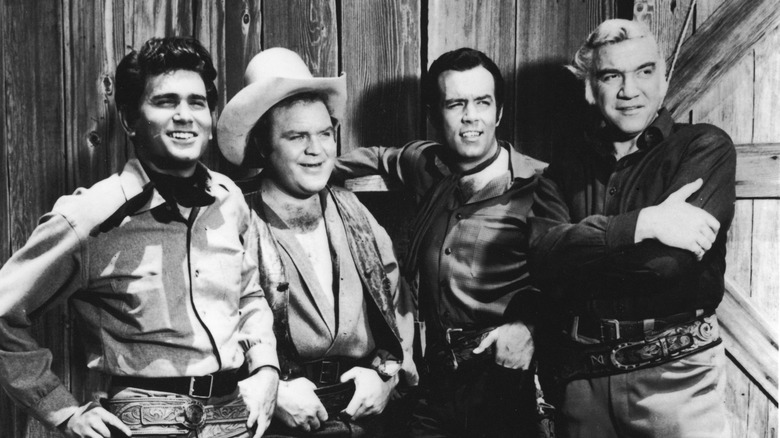The Best TV Shows Of The 1960s
The 1960s were a turbulent time. Americans were in the midst of the Vietnam War, while civil rights action, protests, and political assassinations were dominating headlines back home. However, it was also a time of love and peace. Families were transitioning from what was portrayed on shows such as "Father Knows Best" to what would later become "All in the Family" in the '70s. After dinner, parents and children would congregate in their living rooms to watch television together. It was a popular form of entertainment for the nuclear family and a way for them to spend quality time with one another before going to bed.
TV sitcoms and variety shows presented a form of escapism for '60s viewers. Young children watched Saturday-morning cartoons, while older kids and adults tuned into westerns and sci-fi programming such as "The Twilight Zone" and "The Outer Limits." Much of '60s television was filmed in black and white, and many of the shows were old-fashioned, heartwarming fun, with series often centering around family values. Even today, a number of these programs are highly regarded and considered some of the best shows in history, and several are still in syndication, drawing new, younger fans who weren't yet born during their initial runs. Let's take a look at some of the most popular shows of the 1960s.
The Twilight Zone
Rod Serling famously delivered this opening narration to "The Twilight Zone": "There is a fifth dimension beyond that which is known to man. It is a dimension as vast as space and as timeless as infinity. It is the middle ground between light and shadow, between science and superstition, and it lies between the pit of man's fears and the summit of his knowledge. This is the dimension of imagination. It is an area which we call the Twilight Zone." The show debuted in 1959 and aired through 1964 on CBS, and it left such a cultural impact that it was rebooted in 2019 with Jordan Peele at the helm, according to Vulture.
The sci-fi/horror series was a great metaphor for life's dreams, tragedies, and other experiences. Sterling wrote most of the episodes, and a plethora of stars appeared on the program, including Robert Redford, William Shatner, Burt Reynolds, Carol Burnett, Charles Bronson, Buster Keaton, and Mickey Rooney, according to TV Tropes. What was the show about? Episodes such as "He's Alive" focused on dictator Adolf Hitler instructing Dennis Hopper on how to be a demagogue, while "Nightmare at 20,000 Feet" starred Shatner, who had to cope with a monster on an airplane. Nearly each episode featured some sort of moral, such as "Beauty is in the eye of the beholder."
The Carol Burnett Show
"The Carol Burnett Show" didn't start production until 1967, but it turned into a hit that aired on the small screen for over a decade. Stars such as Harvey Korman, Tim Conway, Vicki Lawrence, and Lyle Waggoner made regular appearances on the series, which was one of television's top musical-comedy programs and variety shows of its time. The show is consistently listed as one of the best of all time, but its ratings didn't match its critical success, according to MeTV. "The Carol Burnett Show" only peaked at No. 13 in the Nielsen ratings and typically found itself in the 20s during its run.
Viewers loved Burnett's "working class persona," according to the Television Academy Foundation. They also liked her ability to mingle with a slew of famous stars while exhibiting her own charm and wit. Guests included luminaries such as Lucille Ball, Liza Minelli, Cher, Julie Andrews, and Sammy Davis, Jr. The program was a great mix of musical comedy, slapstick humor, and drama with a splash of vaudeville. "The Carol Burnett Show" stayed on the air until 1978, which was a testament to its popularity because variety shows had long passed their peak by that time.
The Andy Griffith Show
"The Andy Griffith Show" was one of television's most popular shows. It aired on CBS from 1960 to 1968 with 249 episodes filmed, according to NCpedia. Andy Griffith played widower Sheriff Andy Taylor of the fictional town of Mayberry, North Carolina, which featured that small-town charm where the characters had a penchant for gossip but always took care of each other. During its first season, the series was the No. 1 situation comedy on television, and by its final season, "The Andy Griffith Show" was No. 1 overall.
The success of the program was driven by its writing and actors, which were top-notch. In addition, the show painted a picture of an idyllic Southern environment, which was the opposite of the climate of the '60s. It featured themes such as justice and humanity, an escape from the issues that viewers were facing on a day-to-day basis in real life, including racism and the Vietnam War. Many episodes ended with Andy peacefully solving some sort of problem. The series also launched a spin-off, "Gomer Pyle, U.S.M.C."
The Dick Van Dyke Show
CBS had another hit with "The Dick Van Dyke Show," which aired from 1960 to 1965 and was filmed in black and white, like most programs during the decade. Creator Carl Reiner based the sitcom on his own life and his time working as a writer on "Your Show of Shows" with Sid Caesar while he was married and raising a family, according to the Writers Guild of America West. The series starred Dick Van Dyke and Mary Tyler Moore, who are considered some of the best comedic actors of their time. Van Dyke played comedy writer Rob Petrie, while Moore played his wife Laura Petrie. It was filmed in front of a live audience, which was rare at the time, according to Wide Open Country. The show was in danger of cancellation following its first season, but ratings were boosted during Season 2, when it aired after the popular series "The Beverly Hillbillies."
"The Dick Van Dyke Show" won 14 Emmy Awards, including several for its leading actors. The series was massively popular because it was so unique. For example, pants-wearing Moore did not act like the typical housewives seen on programs such as "Leave it To Beaver," making her one of television's original feminists. It consistently ranked in the top 10 shows on television, and it was still at the top of its game when it ended its run.
The Beverly Hillbillies
"The Beverly Hillbillies," also a sitcom on CBS, centered on the Clampett family, which relocated to Los Angeles after discovering oil on their property and making a whole lot of money. The show's characters included Jed, Granny, Jethro, and Elly May, who amused viewers with their zany antics. The program aired from 1962 to 1971 and was so popular that it led to merchandising deals, spin-offs, and a 1993 movie starring Diedrich Bader, Cloris Leachman, Erika Eleniak, and Jim Varney. According to MeTV, the TV series was massively successful because it was just so stinking funny.
Just six weeks after it first aired, the show was No. 1. It averaged 57 million viewers between 1962 and 1964 and included some of the most-watched episodes of the decade. One episode in particular, "The Giant Jackrabbit," remains one of television's most-viewed half-hour episodes of all time. At one point, 44 percent of American viewers were watching the show. While critics didn't like it very much, the general public certainly did. However, series with rural themes such as "The Beverly Hillbillies" were given the heave-ho in the early '70s as viewers turned to different types of programming such as "The Mary Tyler Moore Show."
The Addams Family
"The Addams Family" was initially depicted by cartoonist Charles Addams in The New Yorker as early as 1938. He portrayed his eccentric characters as people who enjoyed the macabre and didn't know or didn't seem to care how they looked to those around them. In 1964, ABC launched the television series, which only aired for two seasons but left a lasting mark on TV history. Characters included Gomez Addams, Morticia Adams, Lurch, Uncle Fester, Pugsley Addams, Wednesday Addams, and Cousin "IT," according to The Bamboo.
The black-and-white show centered around the family and how its behavior was different from others in society. The series featured a catchy theme song with what is now known as those iconic finger clicks, which are still familiar to many people today. The show spurred a successful movie franchise starring Raul Julia, Anjelica Huston, and Christopher Lloyd, and it's not dead yet. In 2020, filmmaker Tim Burton started developing a new show based on the characters, according to Deadline. The live-action series will allegedly be from the viewpoint of Wednesday Addams, who is navigating life in the 2020s.
Gilligan's Island
"Gilligan's Island" aired from 1964 to 1967 and centered on seven men and women who were forced to survive on an island after their ship wrecks. TV critics derided the first season for its ridiculous storylines, but the series remained in syndication for decades and is beloved by many fans, according to Encyclopedia.com. Created by Sherwood Schwartz, the same man who delivered "The Brady Bunch," the program finished first in its time slot during its entire three-season run. CBS eventually pulled the series to make room for "Gunsmoke."
The show featured the Skipper, his sidekick Gilligan, the Professor, rich couple Mr. and Mrs. Howell, country girl Mary Ann, and movie star Ginger. Nearly each episode centered on the castaways' plans or desire to get off the island. Yet, they failed often, largely due to Gilligan's crazy antics. 1978's "Rescue from Gilligan's Island" became one of television history's highest-rated made-for-TV films, and the castaways finally went home. However, they were not happy with their newfound freedom, and they ended up back on the island, where they presumably lived happily ever after.
Bewitched
"Bewitched" first aired on ABC in 1964 and centered on a witch/housewife named Samantha Stephens, whose signature characteristic was wiggling her nose when she performed magic. Interestingly, the trait was a camera trick, and Elizabeth Montgomery, who played Samantha, was actually moving her mouth, not her nose, according to Time. Throughout the series, Samantha did whatever she could to keep her witchy ways a secret from her husband Darrin, who was clueless about her hidden talents.
At one point, the original Darrin, played by Dick York, was inexplicably replaced by Dick Sargent. In addition, the character Gladys Kravitz was played by two actresses: Alice Pearce and Sandra Gould. "Bewitched" aired for eight seasons and had 254 episodes. It often got better ratings than its CBS competition, "All in the Family."
Herbie J. Pilato, author of "Twitch Upon A Star," said the show was canceled due to Montgomery's personal problems, not low ratings (via Fox News). While the show had been renewed for two additional seasons, the actress was finished. Pilato explained: "It was at this same time that Montgomery's marriage to [Bill] Asher began to unravel. The sitcom came to an end in 1972 and the couple divorced a year after."
Wagon Train
"Wagon Train" aired on NBC from 1957 until 1965 and was the network's way of breaking into the western genre. The show featured a slew of guest stars, often plucked from film, who appeared alongside series regulars such as Ward Bond and Robert Horton, according to the Television Academy Foundation. Executives allowed spending of $100,000 per episode, which was significantly more than its competition, which spent about $70,000 per episode on their western series. The show was a success due to its excellent scripts and direction. The producers believed the program was just as good as what audiences watched in movie theaters, and those audiences ate it up.
The show centered on people traveling from St. Joseph, Missouri, to California on a wagon train caravan. Every week, viewers got a view of the American West and its variety of characters. "Wagon Train" aired for eight seasons and was even moved from NBC to ABC, which, interestingly, didn't effect its popularity. There was also a variety of cast member changes, and only Frank McGrath, who played the cook Charlie Wooster, and assistant wagon master Bill Hawks, played by Terry Wilson, stayed on for the entire series. The show's closest rival was "Gunsmoke," but "Wagon Train" hit the top spot in the ratings in 1960 and held onto that spot in the 1961-62 season.
Get Smart
The cult classic "Get Smart" aired from 1965 to 1970 and centered on a not-so-bright secret agent named Maxwell Smart, played by Don Adams, and his battles against an evil organization called KAOS. Smart was not your typical secret agent; in fact, he was dumb and self-centered. Still, he was supported by Agent 99, played by Barbara Feldon, who stuck by his side and was in love with him, a fact he simply didn't figure out until later seasons. The show was successful because of its spy theme, which was big in the 1960s. Other popular spy shows of the time included "The Man From U.N.C.L.E", "I Spy," and "The Avengers," according to Nostalgia Central.
Smart was known for delivering catchphrases, such as "And loving it" and "Sorry about that, chief," and the show was so popular that several of the original actors appeared in a series revival in the mid-'90s. Adams played the chief, Feldon played a congresswoman, and Andy Gill played their son, a secret agent named Zach Smart. Unfortunately, it didn't resonate with viewers nearly as well as the original and was canceled after just seven episodes.
Star Trek: The Original Series
Hindsight is 20/20, and "Star Trek: The Original Series," which is considered one of television's most influential shows, only lasted three seasons on NBC from 1966 to 1969. The show featured incredible special effects and combined science fiction with powerful messages about humanity, yet it simply didn't perform particularly well in the ratings during its initial run. By the third season, it was pushed to a 10 p.m. Friday time slot, which was a death knell, according to CBR.com.
The program was put into syndication the same year it was canceled, and it actually performed much better than when it aired new episodes. It became so popular that it spawned an animated spin-off, fan conventions, and a film franchise, growing a huge fanbase despite its difficulty attracting an audience during its first run on network television. The program proved that a cancellation caused by budget cuts and a bad time slot doesn't necessary equal failure. Through reinvention, "Star Trek: the Original Series" defied expectations and became one of television's most groundbreaking shows.
Bonanza
"Bonanza" aired from 1959 until 1973 for 14 seasons and 431 episodes. It's considered one of TV's best westerns and led to successful careers for actors Michael Landon, Lorne Green, Pernell Roberts, and Dan Blocker. The series centered on the Cartwright family and how they navigated their lives on the Ponderosa Ranch in California. During the first season, Green recommended some changes to the show, and he later explained, via Newsner, "Instead of being a western Shoot 'Em Up, it became a series about a four letter word, love. Love of land, trees, environment, people, country. Love."
Viewers of all ages loved "Bonanza's" cast of characters and western theme, as well as its focus on family values. Plus, it featured beautiful sets both inside and outdoors. It was also the first series to be filmed completely in color instead of black and white. Unfortunately, when Blocker died after Season 13, the actors had a hard time pressing on. They were able to do so, but the series was cancelled after the 14th season.
